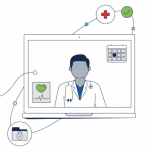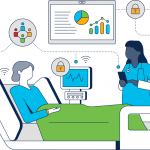It’s an exciting time in healthcare. New tools. New technologies. The opportunities for improving care for patients and optimizing how clinicians, IT, and hospital administrators do their jobs may seem endless.
With all the possibilities out there, how do you know your investments in new technologies are going to have a real impact? Taking those next steps all begins with understanding where your efforts can have the biggest impact – for patients, clinicians, administration, and IT.
Seeking medical care can be overwhelming and confusing. With in-person and virtual services, it’s possible to deliver 24-hour care that’s easy to access and navigate, increasing patient and caregiver engagement and satisfaction.
Think about the last time you needed to make a doctor’s appointment. For example, a trip to the doctors can mean making a call, waiting on hold, and repeating information you know your doctor already has. Then, you have to pick an appointment date and time possibly weeks in the future. What if your plans change, and you can no longer make the appointment? You start the process all over again.
But there is a better way. Population Health Outreach and EHR-Integrated Telehealth capabilities can help improve the experience. One example is Luma Health. They’ve built a telehealth bot that’s integrated directly with Webex Teams. So when a patient cancels an appointment, Luma Health determines if they are eligible for a telehealth visit. That decision is based on appointment type, characteristics (diagnosis and procedure), and provider preference. If a patient qualifies and agrees to a telehealth visit, then the patient and provider can join a private room. Finally, when the visit is complete, the room is deleted to ensure privacy.
Technology should help staff provide care, not create barriers. From preventive to specialized care, solutions that help clinicians communicate and stay connected boost effectiveness and efficiency. As a result, this improves care team coordination and collaboration.
For Parkview Medical Center in Colorado, the answer to a better clinical experience was mobile technology. For example, it frees clinicians to focus on the more meaningful work of patient care. Since implementing Clinical Communications and Collaboration solutions, the organization has experienced a 60-minute reduction—per nurse, per shift—in the time spent on documentation and coordination. Less time on documentation means each nurse has one hour more each shift to spend at the patient bedside.
Additionally, the benefits of mobility solutions aren’t just limited to clinicians. Parkview has seen a 210% increase in their HCAHPS score (Hospital Consumer Assessment of Healthcare Providers and Systems), which measures the patient’s view of their care experience.
On the road to a better bottom line, IT should serve as a facilitator, not a bottleneck. Transforming healthcare operations can help increase efficiency, reduce waste, keep costs down, boost staff productivity, and automate your network.
Meander Medisch Centrum (Meander Medical Center) in the Netherlands needed to be ready to support any new technology to transform how patient care is delivered and help save lives. In an effort to deliver new services and capabilities, they rolled out Next Generation Data Center capabilities.
By expanding their underlying data center infrastructure, Meander was able to be more flexible, and easily manage their systems to support innovation. As a result, they accelerated the deployment of new services for patients and clinicians by 400 percent. Also, Meander has reduced IT management time by up to 75 percent, while increasing server utilization by 40 percent.
Healthcare is more connected than ever. As a result, there are new opportunities but also new vulnerabilities. As cybersecurity threats grow increasingly sophisticated and frequent, organizations need to find innovative ways to provide IT security and meet regulatory requirements.
Ensuring Network and Micro-Segmentation and creating a holistic, effective device security strategy should be priorities organization-wide. For Sentara Healthcare that means doing more with less and providing a highly secure, digital care environment. With 300-plus care sites, this is a constantly moving target. In order to protect connected administrative and research networks, medical devices, guest wireless, and more from cybersecurity threats through network segmentation, Sentara completed a full network refresh.
During that process, Sentara secured 140 physical locations and 45,000 endpoints in just 14 months. That result would have been impossible with their old approach. For example, they can now segment and control access to critical-care devices, points-of-sale, building control systems, and other high-risk endpoints. As well as secure high value data, including protected health information and payment card details.
With the interactive Healthcare Portfolio Explorer, you can delve into each use case across patient experience, clinical experience, security and compliance, and operations. Through this tool, discover case studies and see technical overviews that show the technology that brings these solutions to life.







CONNECT WITH US